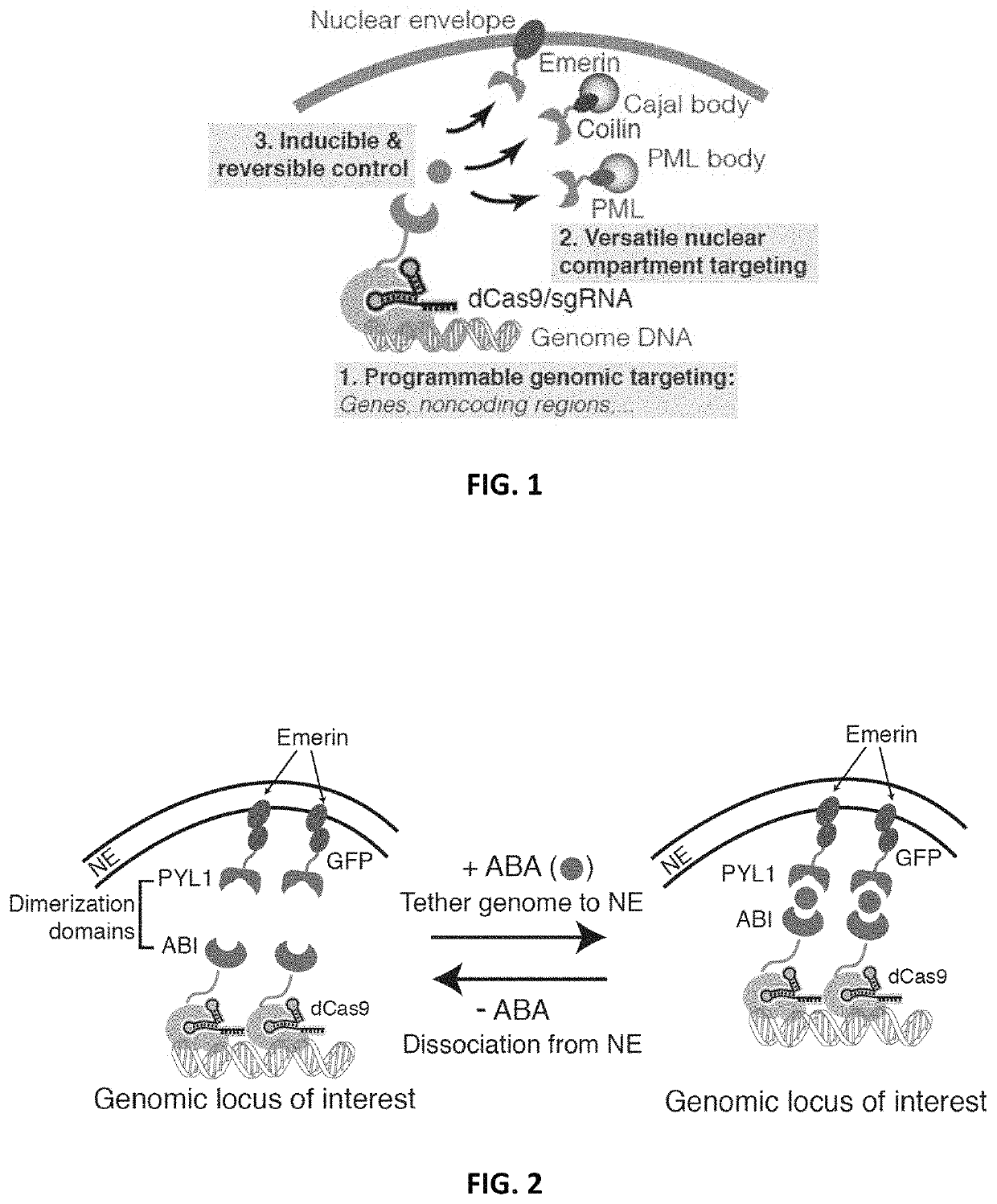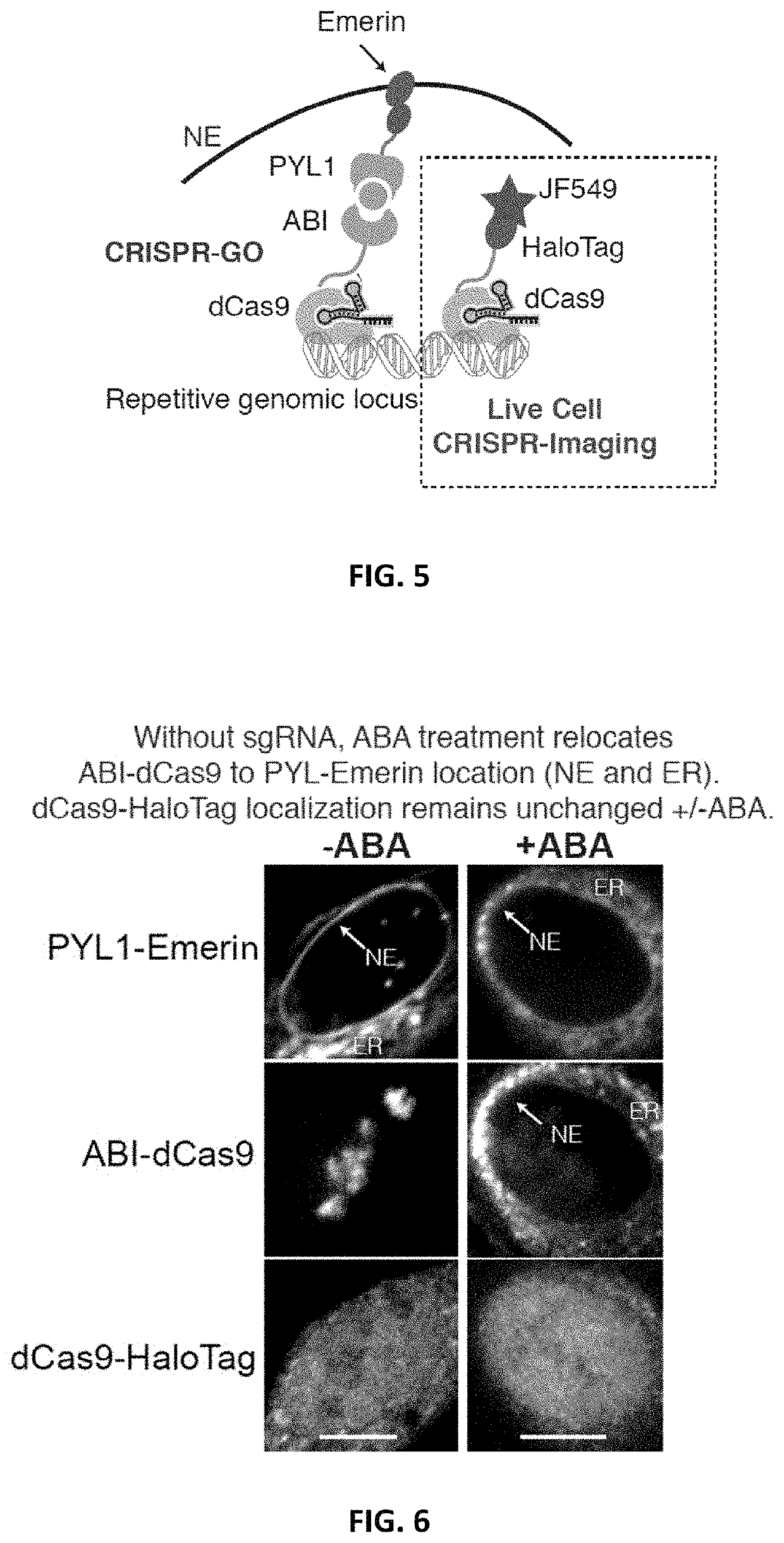Systems and methods for polynucleotide spatial organization
- Summary
- Abstract
- Description
- Claims
- Application Information
AI Technical Summary
Benefits of technology
Problems solved by technology
Method used
Image
Examples
example 1
nt of a Chemical-Inducible CRISPR-GO Platform for Target-Specific Genomic Repositioning
[0201]To implement an inducible CRISPR-mediated chromatin repositioning system, two chemical-inducible heterodimerization systems were tested. The first was an abscisic acid (ABA) inducible ABI / PYL1 system, and the second was a TMP-Htag (Trimethoprim-Haloligand) inducible DHFR / HaloTag system. For both systems, the Streptococcus pyogenes dCas9 (D10A & H840A) protein was fused to one heterodimer, and an inner nuclear envelope (NE) protein, Emerin, was fused to the cognate heterodimer (FIGS. 2-4). Emerin, encoded by the EMD gene, is among a group of LEM (LAP2, Emerin, MAN1)-domain proteins that mediate chromatin organization at the nuclear inner membrane. Emerin is synthesized in the cytoplasm, inserted into endoplasmic reticulum (ER), and then translocated to NE through diffusion within the contiguous ER / NE membranes (Berk et al., 2013). U2OS human bone osteosarcoma epithelial cell lines were create...
example 2
Repositioning of Repetitive Genomic Loci by the CRISPR-GO System
[0204]In addition to the Chr3:q29 locus, repositioning other highly repetitive endogenous genomic loci, including Chr13 locus and telomeres, to the nuclear periphery was tested. Using an sgRNA targeting repetitive region (˜350× repeats) on Chromosome 13q34 (Chr13) (FIG. 7), the percentage of tethered Chr13 loci increased from 13% (n=103) to 69% (n=157, p<0.0001), and the percentage of cells containing at least one periphery-localized locus increased from 34% (n=30) to 94% (n=53, FIG. 8, p<0.0001). Similarly, CRISPR-GO-containing cells with a telomere-targeting sgRNA were transduced to test whether telomeres could also be repositioned with our system. TRF1-mCherry, a telomere marker, was also co-expressed to visualize telomeres. In this case, the percentage of periphery-localized telomere loci increased from 26% (n=1255) to 65% (n=491, FIG. 8, p<0.0001).
[0205]A synthetically integrated LacO array located at Chromosome 1p...
example 3
Repositioning of Non-Repetitive Genomic Loci by the CRISPR-GO System
[0207]Though repetitive sequences are abundantly present in human genome, it is of further interest if the CRISPR-GO system enabled repositioning non-repetitive genomic loci. The non-repetitive gene XIST located at ChrX q13.2, was first targeted and 13 sgRNAs tiling the XIST genomic region were designed (FIG. 17). All constructs were lentivirally transduced into U2OS cells that stably expressed the CRISPR-GO system. With ABA treatment, the percentage of periphery-localized XIST loci increased from 39% (n=83) to 79% (n=71, p<0.0001), and the percentage of cells containing periphery-localized loci increased from 59% (n=39) to 90% (n=33) (FIG. 18, 1H, p=0.0028). Using a pool of 9 sgRNAs targeting regions adjacent to and within the gene PTEN at Chr10 (FIG. 17), the CRISPR-GO system increased the percentage of periphery localized PTEN loci from 39% (n=128) to 61% (n=308, p<0.0001) and the percentage of cells containing a...
PUM
| Property | Measurement | Unit |
|---|---|---|
| Time | aaaaa | aaaaa |
| Nanoscale particle size | aaaaa | aaaaa |
| Time | aaaaa | aaaaa |
Abstract
Description
Claims
Application Information
 Login to View More
Login to View More - R&D
- Intellectual Property
- Life Sciences
- Materials
- Tech Scout
- Unparalleled Data Quality
- Higher Quality Content
- 60% Fewer Hallucinations
Browse by: Latest US Patents, China's latest patents, Technical Efficacy Thesaurus, Application Domain, Technology Topic, Popular Technical Reports.
© 2025 PatSnap. All rights reserved.Legal|Privacy policy|Modern Slavery Act Transparency Statement|Sitemap|About US| Contact US: help@patsnap.com



